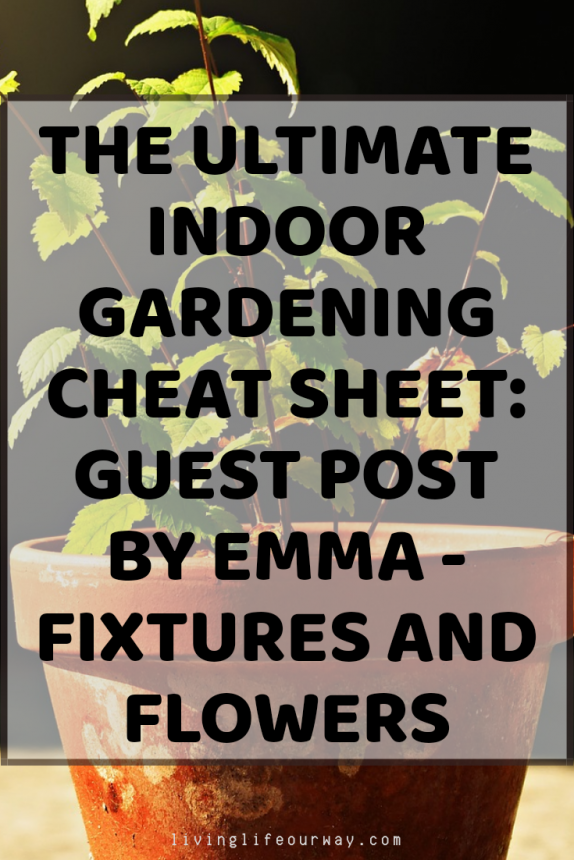It’s a scientific fact that plants breathe life into the atmosphere. Without plants or trees to absorb carbon dioxide and produce oxygen the human race would have no source of clean air. The world would be forced to breathe recycled or artificially produced oxygen.
The more plants there is then, the less pollution there is. Cities with more trees have healthier populations than those that only have a park or two. This premise applies to individual homes as well. A household would greatly benefit from having more plants inside the residence.
The size of the home is irrelevant, what matters is that there are plants indoors to help clean the air. Other than a natural air purifying system, indoor plants can also produce fresh herbs, vegetables and even fruits. Starting an indoor garden is not all that difficult. Take a look at this ultimate indoor gardening cheat sheet to make it easy…

Planting in Soil using containers
The style of using pots and decorative planting containers is the classic method for indoor gardening. It is also one of the most popular and convenient ways to start an indoor garden. The containers can be made of any material, ceramic, metal, plastic or even stone.
There is a timeless beauty in using free-standing containers. They bring a touch of nature indoors and brighten any room as well. They are also easy to handle because one can move them around the house with ease. There are a few things to keep in mind before starting an indoor garden using containers.
Sun spot
Choose an area in the house that takes inadequate sunlight. Proper sunlight is essential for a plant to reach its full potential. As long as the spot gets at least four to six hours of daylight then that should be enough.
Position the plants in that sun spot and decorate around it. Setting the plants in sun-filled setting will be easier than having to move the pot or container outside for it to get some sun.
Soil
Choose the kind of plants that are suitable to be grown indoors. Different types of soil fit the needs of specific plants. Research the type of soil required for the plants before starting an indoor garden. Each kind of plant needs a particular kind of soil.
Preparing the right soil for potted plants is crucial to keep them healthy. For most plants, a store-bought potting mix is an excellent soil base to start with. Then mix that with some compost, and that will create the perfect soil to nurture indoor plants.
Succulents would need a gritty mix that drains well. This is one of those cases where crushed gravel would be the perfect top dressing. Don’t forget to add homemade fertilisers to give your plants more nutrients.
Water
All plant life needs water on a regular basis. That is their primary form of sustenance. Plants absorb water and carbon dioxide to jumpstart photosynthesis.
Water the potted plants using a watering can. Water them early in the morning so that they have the whole day to absorb the water through their roots.
Hydroponics
Indoor gardening has gone through many innovations over the years, and hydroponics is one of them. Hydroponics is a soilless growing system that substitutes soil with an inert media. The purpose of the inert media is to hold the plant upright. It is the base of the plant which suspends it over the water.
Water culture
This is often used in the most basic hydroponics systems. To grow plants in water culture, first put each plant in a container or a growing tray filled with inert medium.
Then immerse the plant containers in an even bigger container filled with nutrient solution. For best results, use an air pump to create bubbles in the nutrient solution to help with aeration.
Nutrient film
This technique foregoes the use on any inert media and suspends the plants right over the nutrient solution. Holes are drilled through PVC tubes to house the plants, and their roots are allowed to grow at the bottom directly immersed in the nutrient solution. It is also advised to use an air pump when using this method to promote root aeration.
Drip system
Instead of the plants being suspended over the nutrient solution. This hydroponic growing technique circulates the nutrient solution throughout the growing media. A water pump continuously pumps the nutrient growing solution.
Aquaponics
This indoor growing technique would be perfect for people that own and love their aquariums. Instead of suspending the plants over a container with a nutrient solution this technique uses the nutrient from fish waste and feeds it directly to the plants.
The plants are set on top of a growing media which is then placed atop the fish tank. The microorganisms in the growing media would then break down the fish waste into proper nutrients for the plants. The plants would then absorb these nutrients.
The microorganisms found in the growing media would technically clean the water of any waste. Aquaponics is an efficient solution to the disposal of fish waste and cost-effective as well because it forgoes the need for the nutrient solution.
Aeroponics
Aeroponics is another new growing technique that can be used for indoor gardening. Here, the plants are housed in containers that do not have any soil and isn’t immersed in any nutrient solution. The containers are there to support the plant and provide access when water is sprayed.
The lower half of the container is filled with small holes or grills which allow the grower to spray water or nutrient solution directly on the roots. This is the same growing technique used by astronauts and is gaining popularity all over the world.
Conclusion
There are several paths to start practising indoor gardening. Choose the technique that best suits your personality. Consider all the factors, pros and cons of each growing technique. No matter what method is used the end results will be the same. Cleaner oxygen, fresh vegetable, fruits and a healthier lifestyle.
Author Bio

Emma is a part-time property developer, part-time home improvements and gardening blogger at Fixtures and Flowers, and full time Mum. Given her background, Emma has a lot of advice, tips and tricks that she loves sharing on her blog.

Amazing piece of content thanks for sharing